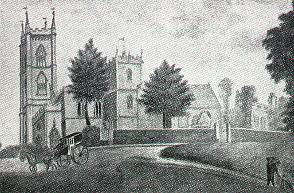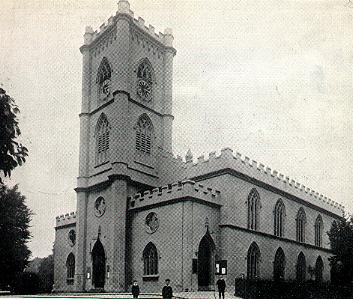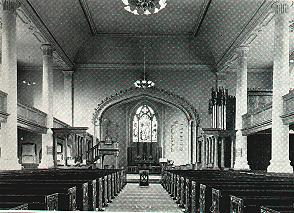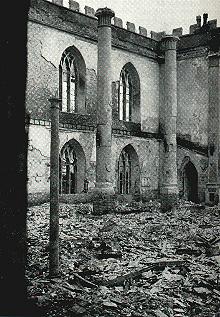
St Andrew, CLIFTON
Bristol
It is hard to imagine today but St Andrew's church was once a village church outside of the city. It is first mentioned in 1154 when it was given to the Abbey of St Augustine (now Bristol Cathedral). The medieval church was not large, and was partially rebuilt in 1654. The first enlargement of the church that is recorded was in 1716 when a new aisle was added, indicating the growing population of the parish by then. John Wesley preached in the church on Sunday May 13th 1739, and commented afterwards on the "many rich" (people) at the service. The church was enlarged further by a south aisle being added in 1768.
Matthew's Directory of 1793/4 has the following description.
"Clifton Church stands on the summit of that part of Clifton Hill, about a quarter of a mile from the boundary of the City at Jacob's Well, and contains in its parish some part of the liberty of Bristol. This Church has a plain outside, the inside is neat, and agreeable; it consists of three ailes, has a gallery the breadth of the whole Church, and many marble monuments, but most of them are small. The tower is of hewn stone, square and low; has pinnacles and two bells. In the Church Yard is a tomb with an urn upon it, and the following inscription:
Sacred to the memory of George Lewis, fourth son of George Lewis of St. Pierre in the county of Monmouth Esq. who was unfortunately drowned in crossing the Severn in a small boat, on Sunday 6th of November 1774, aged 16.
| As some young Pine of aspect tall and fair, |
| That promis'd to reward the Planter's care; |
| Pleas'd he beheld it answering his toil, |
| Thrive, and proclaim the goodness of the soil; |
| When, all at once, a whirlwind blasts his care. |
| Tears up his plant and scatters it in air; |
| So far'd it with the youth we here deplore, |
| O'erwhelm'd at once, and drowned near the shore: |
| The crazy boat unable to sustain |
| Her swelling sail, is buried in the main. |
| In vain for him his friends explore the deep, |
| In vain, with nets, the treach'rous bottom sweep; |
| For six long months, the sport of every wave, |
| His floating body sought in vain a grave; |
| But toss'd from rock to rock, from sand to sand, |
| Till a kind Pilot tow'd his corps to land. |
| Nor should, for this, his friends indulge despair, |
| But with this consolation wipe the tear, |
| That the same GOD is present every where; |
| And the strait gate that leads to endless bliss, |
| Stands in the air, the earth, and great abyss. |
| Nor could a youth like this forsake his way, |
| Had he sat out from Lapland or Cathay |
The population continued to increase and the numbers were swelled by the number of visitors to the Spa (Hot Wells) which was in the parish for whom a chapel-of-ease had been built in Dowry Square in 1744. A new church was therefore inevitable and in 1819 the foundation stone of the new church was laid on a site alongside of the old church. It was complete by 1822 and consecrated on August 12th. The old picture below shows both churches side by side.

The architect of the new church was James Foster. At a time when most buildings were being built in Greek or Roman classical imitation, St Andrew was an odd amalgam of Gothic and Classical forms.

The exterior shows the ignorance of Gothic form. The church is embattled wherever possible and the windows have intersecting tracery or are quatrefoils, on the sides and in the porches housing stairs to the galleries flanking the tower.

The interior shows the strange combination of styles adopted. The windows, the chancel arch and the three sided apse are all in Gothick forms, the fittings, the galleries and especially the piers supporting an entablature and flat or coved ceilings are Classical forms with which the modern architect was more comfortable with. The picture above shows the interior in its final form, an earlier postcard I have shows that flanking the window in the apse were two similarly sized window-shaped boards with blank two-light tracery and painted texts (Commandments, Lords Prayer and Creed), giving the impression of three windows in the apse from the back of the church and a fine two-decker pulpit. The organ was moved to the position shown after 1911 and the old pulpit and chancel fittings were thrown out in favour of more sumptuos choir stalls and screen-like furniture in the east bay of the nave. The U.S. millionaire Andrew Carnegie gave £330 towards the cost of these alterations.

On the night of November 24th the church fell victim to the severe bombing of Bristol by the Luftwaffe. It remained a shell for several years, the ruins being finally demolished in 1956. It had been hoped to save the tower but it was found to be unsafe and soon followed the rest of the church into oblivion. The pretty churchyard survives, together with the path through it called Birdcage Walk. The tombs are in a poor condition sadly. The site of the church is marked by an inscribed stone set in the lawn. The very base of the walls survive in part. The outline of the medieval church was marked out by hedging to the south. Christ Church became the parish church of Clifton, one of eight churches carved out of the former Clifton parish in the nineteenth century.
Back to Bristol churches Index